Loupedeck Live and Loupedeck CT review: Customizable controls for creative pros
The Loupedeck Live or Loupedeck CT can revolutionize a creative professional's workflow, as long as the price doesn't scare you off.
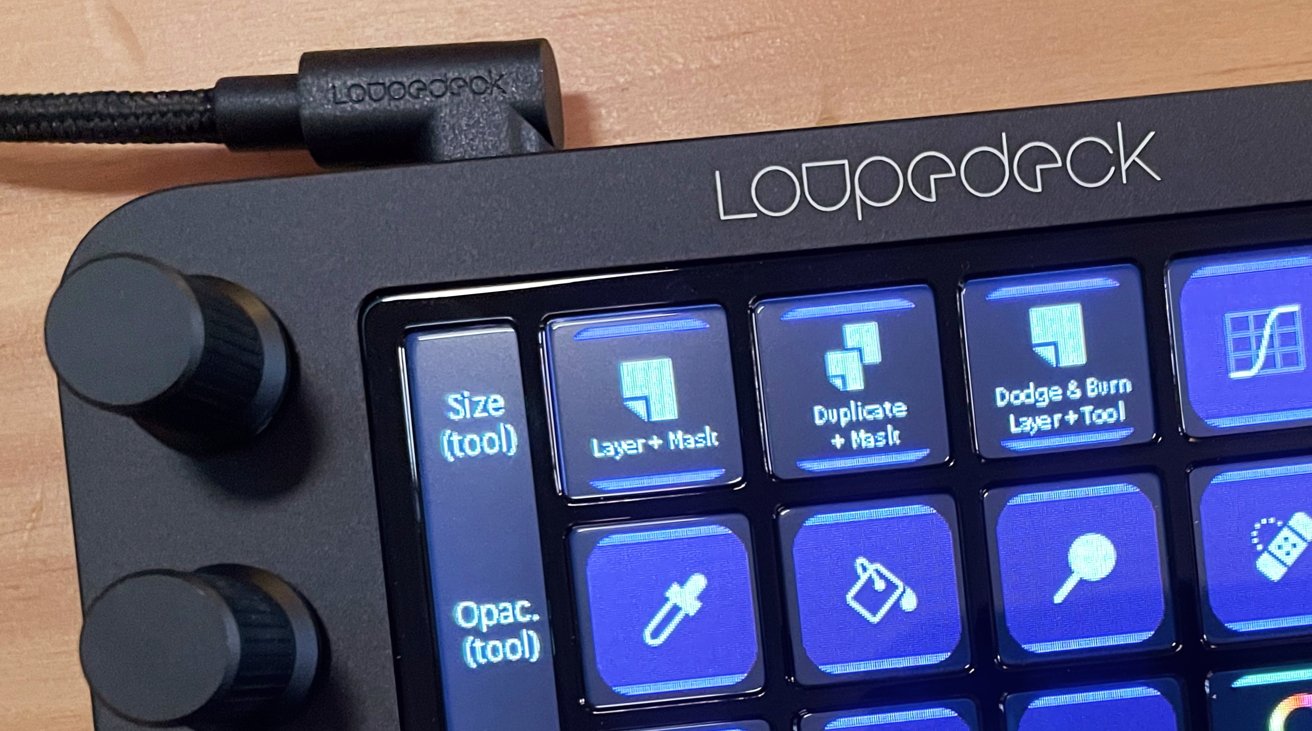
The Loupedeck Live and CT have light-up displays for buttons.
Technology never stops moving forward, and each year, we are treated to all manners of dongles, panels, or tables that bring the tools and functions of applications into clearer focus. Or they improve the overall speed and comfort of daily use.
Depending on your app of choice for creative work, you may be facing a staggering about of buttons, menus, and options. All a result of the need for scores of shortcuts, key commands, and one-button actions.
For an artist like me, that application is typically Adobe Photoshop or Adobe Illustrator on a Mac, with their seemingly bottomless well of options.
While key commands make life easier, there are rare moments when I wished it could be a little more one-click friendly.
However, my desires are eclipsed by the sheer magnitude of options and approaches available to creators working in video editing spaces.
Moving forward and backward, clipping, editing, sound, visual effects, and everything else that goes into video production, can feel like a lot when viewed as a person on the outside looking in.
It feels as staggering as someone brand new to the world of professional graphic designers, illustrators, and photo editors looking at their tools.
The baselines are similar, but the specifics require their own approaches to peripherals. With so many options appearing on the market, it begs the question if there is "One Peripheral to Rule Them All."
Among the companies putting forth contenders is Loupedeck, a Finland-based company with a history of working to streamline workflows for creatives in art, audio, video, and livestreaming. In this instance, we're looking at what its Loupedeck Live and Loupedeck CT models bring to the table for digital artists. and what they could mean for the industry overall.
The Loupedeck CT and Loupedeck Live are fairly similar in concept, in that they are all-in-one controllers for your computer.
Offering a selection of buttons and knobs, you get one-touch controls for various software features. This theoretically removes the need to use keyboard shortcuts or having to scour the menu for them.
If you were to put the Loupedeck CT and Live next to each other, you will see an obvious similarity in design. Both have the same top section, consisting of a large display-like element, consisting of 12 Touch Buttons.
Each of these buttons acts as an individual display, and can be customized to display words, phrases, icons, and other images to describe its currently-enabled function.
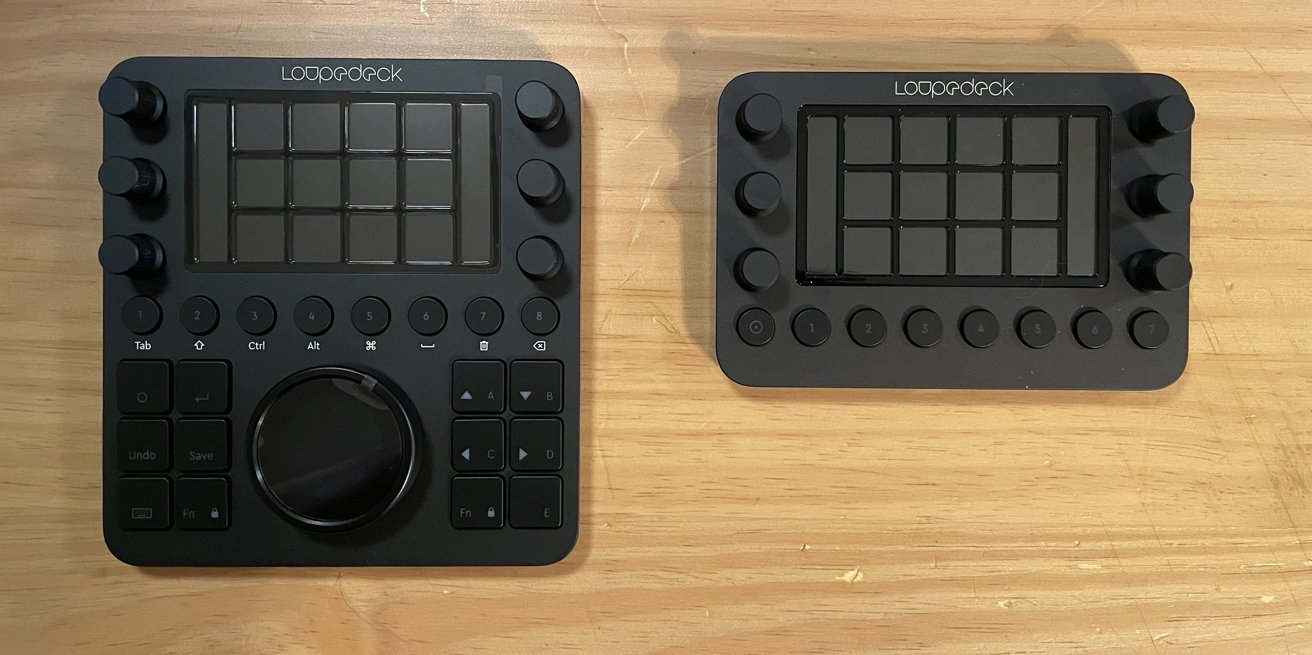
Loupedeck CT (left), Loupedeck Live (right)
Flanking the buttons is a set of six dials, with three knobs on each side. These can twist around, and can also be pushed in for an extra control point, such as resetting the control back to zero or a default point.
Between the buttons and the dials are two long vertical displays, which state what each dial is currently set to control.
Below the dials and the Touch Buttons, there's a row of eight round buttons. While seven of the buttons are customizable, the far left constantly functions as a back or Home button.
While this is where the controls stop for the Loupedeck Live, the Loupedeck CT continues downward with more.
The bottom half of the Loupedeck CT is dominated by a large control wheel, with a built-in touch-enabled display. To the left and right are two banks of six square buttons.
Naturally, the Loupedeck CT is bigger than the Loupedeck Live by a considerable margin. While both measure 5.9 inches across and 1.18 inches thick, the CT is longer at 6.2 inches to 4.3 inches for the Live.
This extra mass also translates into a heavier weight, at 0.5 pounds for the Live, 0.8 pounds for the CT.
Both units are incredibly well made, and you can see and feel the quality in every single aspect of their design and assembly. It's a given that hands-on peripherals can take a bit of a beating over time, simply through daily use.
From the hard case to the touch pads, the buttons, the dials, and the stand included with the Loupedeck Live, everything has that pleasing weight. One that signals Loupedeck products will withstand office-based tasks and life on the go.
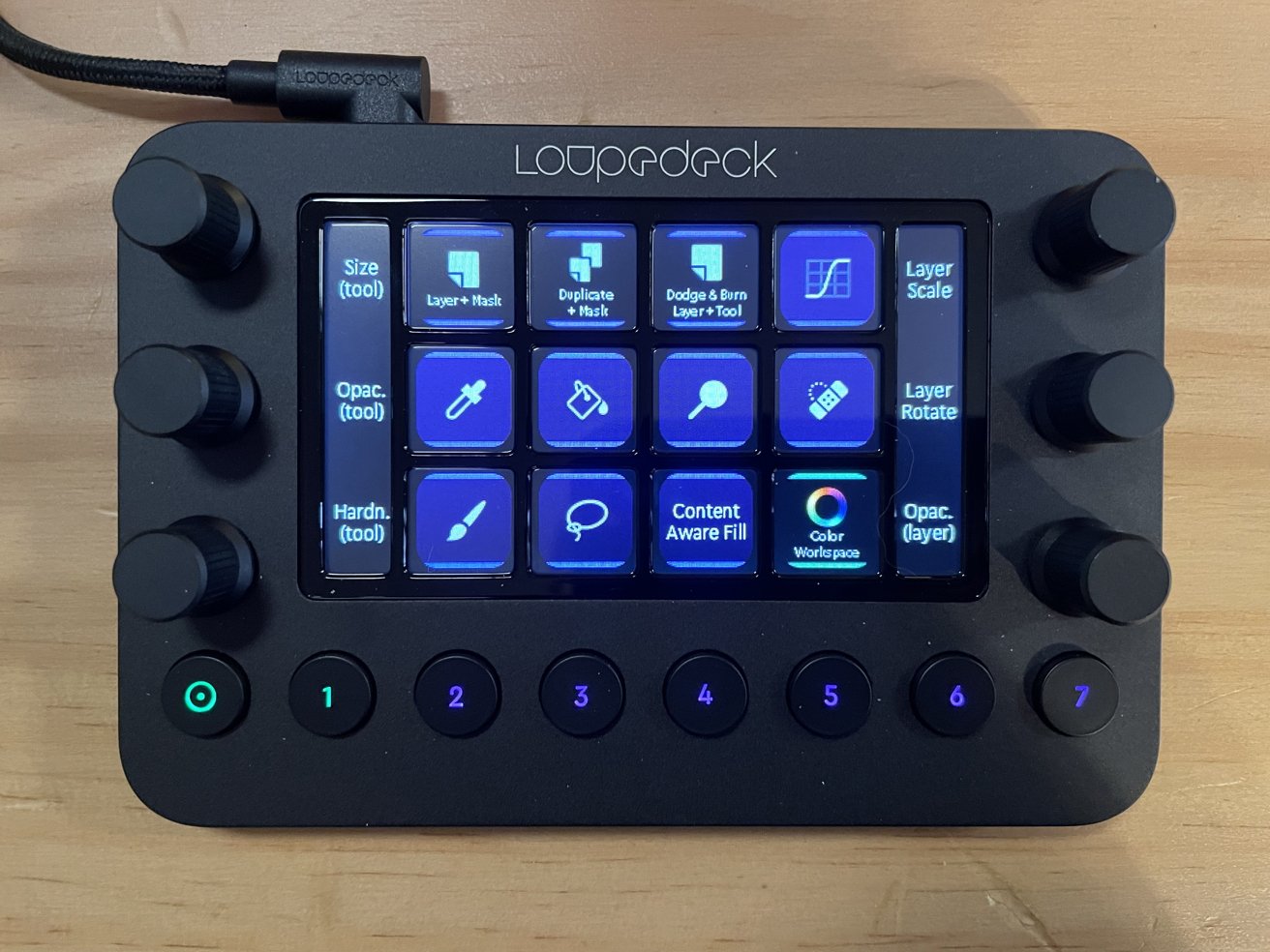
Loupedeck Live is probably a better bet than the Loupedeck CT for streamers.
It's interesting that the Loupedeck Live includes a small stand bracket to place the unit at a 45-degree angle for easier access to the buttons, but the Loupedeck CT does not.
This is a minor thing, and the thought process possibly falls in line with the difference in sizes for the unit. There's also the more immediate hands-on nature of livestreaming to consider, with changing scenes, alerts, and other real-time effects.
Right out of the box, both the Loupedeck Live and Loupedeck CT offer incredible compatibility with a wide range of applications and works with both Mac and PC, supporting macOS 10.14 or later and Windows 10 or later.
After Effects, Audition, Final Cut Pro, Adobe Illustrator, Adobe Photoshop, Premiere Pro, Davinci Resolve, OBS Studio, and far too many more to list are all supported by the Loupedecks in some way.
This list is expanding consistently as more profiles are added to the Loupedeck Marketplace, which offers access to over 70 downloadable profiles, plugins, and icon packs for full customization.
The Loupedeck Live and Loupedeck CT both use USB-C for connection. But while the Loupedeck CT also has a Bluetooth chip installed, it is not currently enabled to allow the unit to connect wirelessly to the host.
This will likely come along in a future update.
It is also worth noting that the Loupedeck CT includes 8GB of internal independent storage that mounts like an external hard drive, which is intended for saving preferences and settings for remote work.
The Loupedeck Live does not include external storage, but given the physical size difference of each unit and the intended focuses on use for each, this feels logical and not a deal breaker.
When I installed both units to my 2018 Mac mini, I was immediately greeted by a preset Photoshop profile that populated all the buttons and dials with some of the most common actions in the app. I was floored.
When I switched from Photoshop to Illustrator, I was floored again.
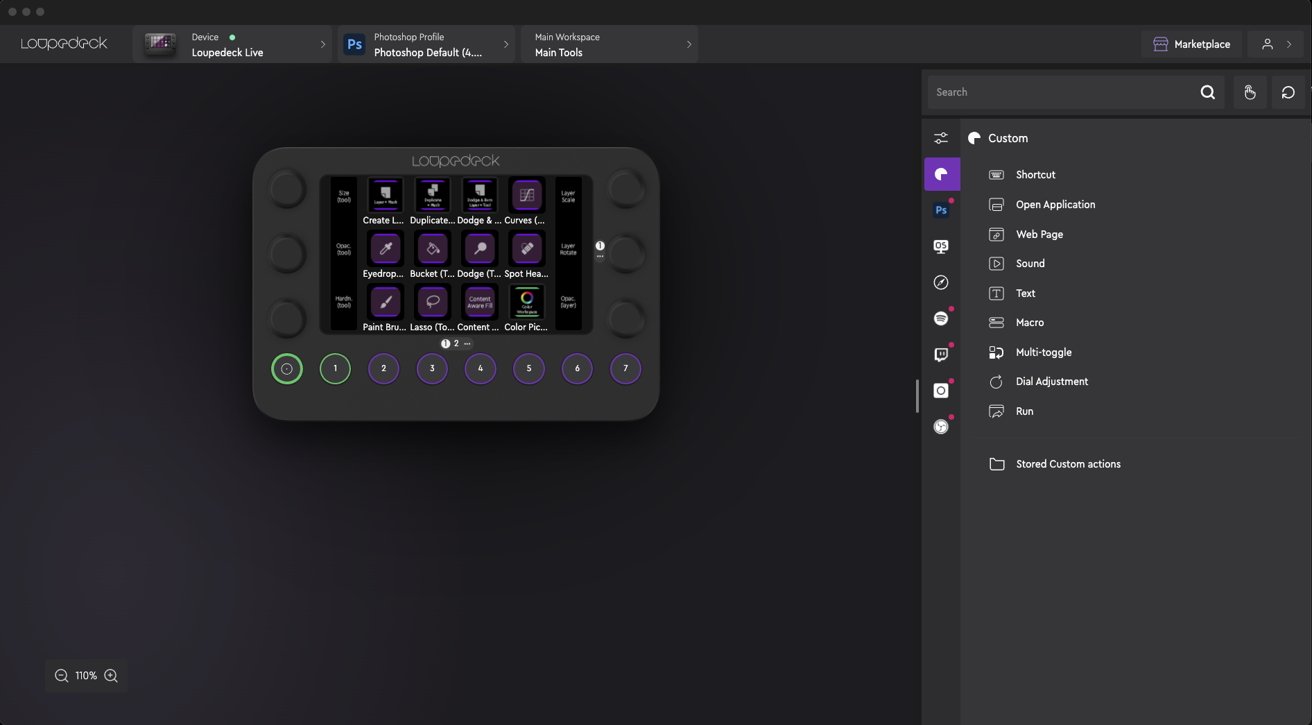
The software used to configure the Loupedeck CT and Loupedeck Live
The software awareness of the Loupedeck Live and Loupedeck CT means that whenever you change your focus between apps, the unit switches with you. There's no need to manually switch to another app profile on the device itself.
In the world of design, moving between apps like Photoshop and Illustrator quickly is the norm. Having a peripheral respond as quickly as you need is huge.
This feature works with all the native app profiles in the Loupedeck Live and Loupedeck CT, as well as for any profiles you create (for music players, video players, etc.) or download from the marketplace, to keep the controls all in one location.
The customization that the Loupedeck Live and Loupedeck CT offers natively and from using the Loupedeck software is staggering. Every button and dial and radial is customizable in each application profile to create the ultimate curated workspace for individuals.
That is one of the few hindrances or growing pains that a new user will experience: the scope of it all. When the software is ready and the Loupedeck is on, you will get into setting up profiles and customizing buttons for workflow and it will all hit you like a truck.
There are so many ways to approach it, that you will want to freeze with analysis paralysis.
My suggestion here is to focus on one app at a time and adjust as you go. The Loupedeck Live and Loupedeck CT have native profiles for the OS that cover things outside of the app profiles, such as volume and screen captures.
Leave things native until you settle in. This was my approach and it saved me from hours of micro-decisions.
Using the Loupedeck CT with my daily workflow was useful. Bouncing between apps and using custom buttons for actions outside of the scope of key commands made things move more quickly.
The use of the radial dial when working with custom colors was novel.
I enjoyed the experience, but in my world, it did not revolutionize my workflow. However, I may not be the target consumer for the Loupedeck CT.
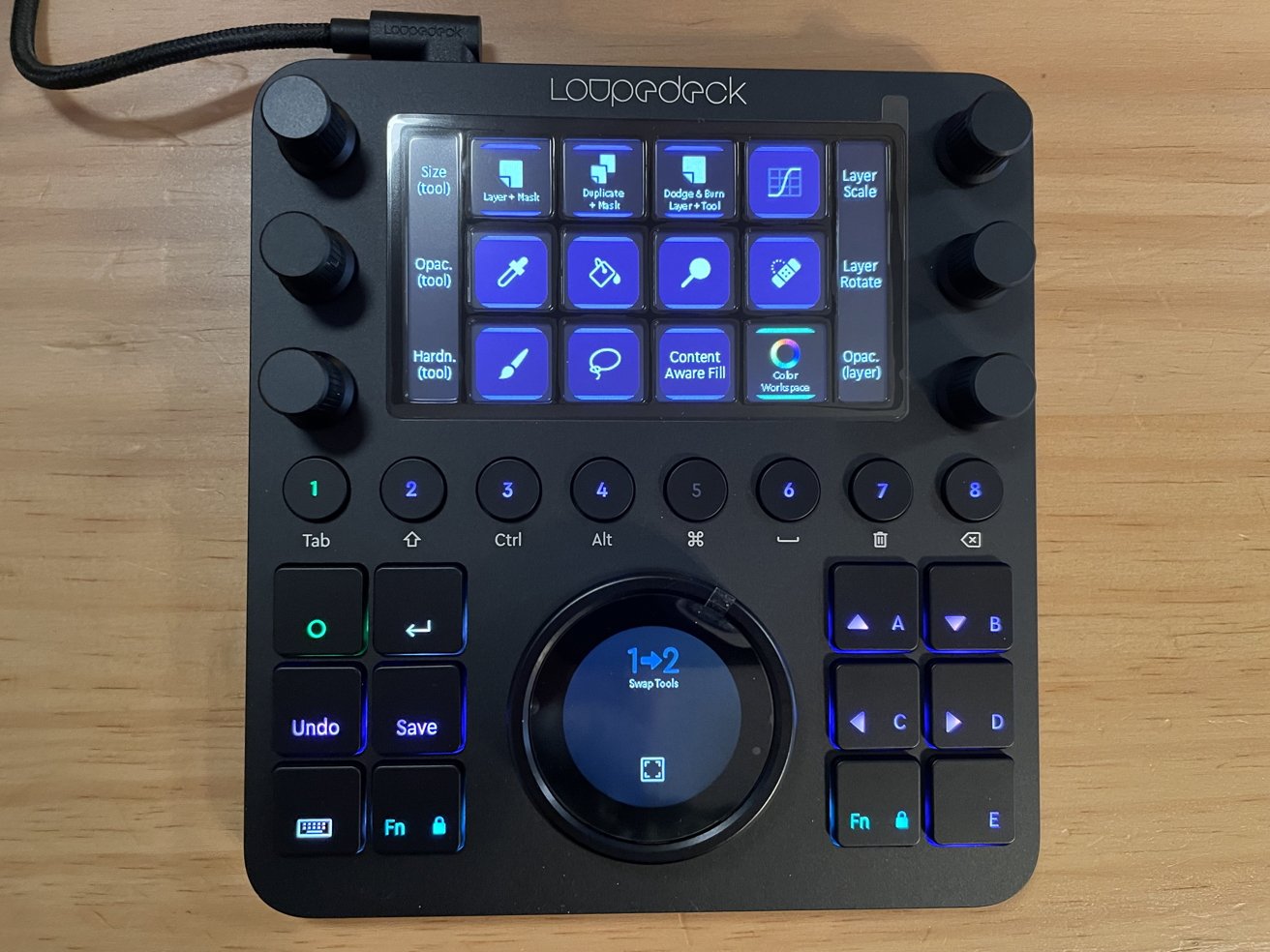
The Loupedeck CT is larger, with a massive dial for analog-like control.
With the Loupedeck Live, I felt like I am getting just the right amount of support and novelty to my workflow for the reasons I described with the Loupedeck CT experience. I had custom buttons and dials for varying actions, and the smooth transitions from Photoshop to Illustrator to a custom Discord profile made a difference.
More importantly, I did not feel like I was driving a Formula One car on a go-kart track. I did not have the nagging sense that I was wasting it somehow like I did with the Loupedeck CT.
Livestreaming with the Loupedeck Live is a phenomenal experience. It is everything an Elgato Stream Deck is, and more.
I own a 15-button Stream Deck and I love it for many of the same reasons, but the Loupedeck Live does everything the stream deck does and more.
The Loupedeck Live has more buttons (31 possible) compared to the standard Stream Deck with 15 total. Loupedeck Live also offers more customization options through the software and marketplace plug-ins, and feels sturdier.
There is a price difference between the two, and you will pay more for the Loupedeck Live, but if livestreaming is more than a passing hobby for you, it would be my choice right now.
The Loupedeck Live and Loupedeck CT are not inexpensive pieces of hardware, with the Loupedeck Live retailing for $249 and the Loupedeck CT retailing for $549.
When I break all the points down on the Loupedeck CT specifically, the unit is far too expensive for my needs as a graphic designer. The usefulness of the added buttons and radial wheel help, but they do not revolutionize my particular process.
As I alluded to above, I would feel like I am wasting the full potential of what the Loupedeck CT can do.
However, in the hands of a video editor, or a livestreamer, the Loupedeck CT sings. If that is your creative focus, this could very well be the peripheral for you.
The upsides are too difficult to ignore if you have the budget to invest, the mental space to expand your muscle memory to an external control panel, and the time to front-load automations.
With the Loupedeck Live, I feel that the $249 price tag is worth the investment for anyone just a half-step about the hobbyist level of livestreaming.
The current 15-button Elgato Stream Deck Mk.2 retails for $149 US, while the new Stream Deck with only 8 buttons and 4 dials retails for $199 US. I believe the additional hundred dollars is worth the investment for the additional buttons, dials, and customization possibilities.
The Loupedeck Live and Loupedeck CT are solid pieces of hardware that offer an incredible depth of customization and workflow possibilities. The price tags could scare away or leave consumers feeling unsatisfied if the proper research isn't taken before purchase.
Read on AppleInsider

The Loupedeck Live and CT have light-up displays for buttons.
Technology never stops moving forward, and each year, we are treated to all manners of dongles, panels, or tables that bring the tools and functions of applications into clearer focus. Or they improve the overall speed and comfort of daily use.
Depending on your app of choice for creative work, you may be facing a staggering about of buttons, menus, and options. All a result of the need for scores of shortcuts, key commands, and one-button actions.
For an artist like me, that application is typically Adobe Photoshop or Adobe Illustrator on a Mac, with their seemingly bottomless well of options.
While key commands make life easier, there are rare moments when I wished it could be a little more one-click friendly.
However, my desires are eclipsed by the sheer magnitude of options and approaches available to creators working in video editing spaces.
Moving forward and backward, clipping, editing, sound, visual effects, and everything else that goes into video production, can feel like a lot when viewed as a person on the outside looking in.
It feels as staggering as someone brand new to the world of professional graphic designers, illustrators, and photo editors looking at their tools.
The baselines are similar, but the specifics require their own approaches to peripherals. With so many options appearing on the market, it begs the question if there is "One Peripheral to Rule Them All."
Among the companies putting forth contenders is Loupedeck, a Finland-based company with a history of working to streamline workflows for creatives in art, audio, video, and livestreaming. In this instance, we're looking at what its Loupedeck Live and Loupedeck CT models bring to the table for digital artists. and what they could mean for the industry overall.
Hardware and Specifications
Aside from the very attractive black-on-black packaging, both boxes and their contents are straightforward and efficient. In short, you get the units themselves, a small instruction pamphlet, and one braided USB-C to USB-A cable.The Loupedeck CT and Loupedeck Live are fairly similar in concept, in that they are all-in-one controllers for your computer.
Offering a selection of buttons and knobs, you get one-touch controls for various software features. This theoretically removes the need to use keyboard shortcuts or having to scour the menu for them.
If you were to put the Loupedeck CT and Live next to each other, you will see an obvious similarity in design. Both have the same top section, consisting of a large display-like element, consisting of 12 Touch Buttons.
Each of these buttons acts as an individual display, and can be customized to display words, phrases, icons, and other images to describe its currently-enabled function.

Loupedeck CT (left), Loupedeck Live (right)
Flanking the buttons is a set of six dials, with three knobs on each side. These can twist around, and can also be pushed in for an extra control point, such as resetting the control back to zero or a default point.
Between the buttons and the dials are two long vertical displays, which state what each dial is currently set to control.
Below the dials and the Touch Buttons, there's a row of eight round buttons. While seven of the buttons are customizable, the far left constantly functions as a back or Home button.
While this is where the controls stop for the Loupedeck Live, the Loupedeck CT continues downward with more.
The bottom half of the Loupedeck CT is dominated by a large control wheel, with a built-in touch-enabled display. To the left and right are two banks of six square buttons.
Naturally, the Loupedeck CT is bigger than the Loupedeck Live by a considerable margin. While both measure 5.9 inches across and 1.18 inches thick, the CT is longer at 6.2 inches to 4.3 inches for the Live.
This extra mass also translates into a heavier weight, at 0.5 pounds for the Live, 0.8 pounds for the CT.
Both units are incredibly well made, and you can see and feel the quality in every single aspect of their design and assembly. It's a given that hands-on peripherals can take a bit of a beating over time, simply through daily use.
From the hard case to the touch pads, the buttons, the dials, and the stand included with the Loupedeck Live, everything has that pleasing weight. One that signals Loupedeck products will withstand office-based tasks and life on the go.

Loupedeck Live is probably a better bet than the Loupedeck CT for streamers.
It's interesting that the Loupedeck Live includes a small stand bracket to place the unit at a 45-degree angle for easier access to the buttons, but the Loupedeck CT does not.
This is a minor thing, and the thought process possibly falls in line with the difference in sizes for the unit. There's also the more immediate hands-on nature of livestreaming to consider, with changing scenes, alerts, and other real-time effects.
Right out of the box, both the Loupedeck Live and Loupedeck CT offer incredible compatibility with a wide range of applications and works with both Mac and PC, supporting macOS 10.14 or later and Windows 10 or later.
After Effects, Audition, Final Cut Pro, Adobe Illustrator, Adobe Photoshop, Premiere Pro, Davinci Resolve, OBS Studio, and far too many more to list are all supported by the Loupedecks in some way.
This list is expanding consistently as more profiles are added to the Loupedeck Marketplace, which offers access to over 70 downloadable profiles, plugins, and icon packs for full customization.
The Loupedeck Live and Loupedeck CT both use USB-C for connection. But while the Loupedeck CT also has a Bluetooth chip installed, it is not currently enabled to allow the unit to connect wirelessly to the host.
This will likely come along in a future update.
It is also worth noting that the Loupedeck CT includes 8GB of internal independent storage that mounts like an external hard drive, which is intended for saving preferences and settings for remote work.
The Loupedeck Live does not include external storage, but given the physical size difference of each unit and the intended focuses on use for each, this feels logical and not a deal breaker.
Setting it all up
Setting up the Loupedeck Live and Loupedeck CT could not be much easier. You need only download and install the Loupedeck software from the company website, and connect the unit via the USB-C to USB-A cable to your Mac.When I installed both units to my 2018 Mac mini, I was immediately greeted by a preset Photoshop profile that populated all the buttons and dials with some of the most common actions in the app. I was floored.
When I switched from Photoshop to Illustrator, I was floored again.

The software used to configure the Loupedeck CT and Loupedeck Live
The software awareness of the Loupedeck Live and Loupedeck CT means that whenever you change your focus between apps, the unit switches with you. There's no need to manually switch to another app profile on the device itself.
In the world of design, moving between apps like Photoshop and Illustrator quickly is the norm. Having a peripheral respond as quickly as you need is huge.
This feature works with all the native app profiles in the Loupedeck Live and Loupedeck CT, as well as for any profiles you create (for music players, video players, etc.) or download from the marketplace, to keep the controls all in one location.
On the desk
Living with the Loupedeck Live and Loupedeck CT on my desk for a few weeks, I came away from the experience with a few takeaways. As a reminder, I am coming at this experience as a graphic designer and illustrator and not as a video editor.The customization that the Loupedeck Live and Loupedeck CT offers natively and from using the Loupedeck software is staggering. Every button and dial and radial is customizable in each application profile to create the ultimate curated workspace for individuals.
That is one of the few hindrances or growing pains that a new user will experience: the scope of it all. When the software is ready and the Loupedeck is on, you will get into setting up profiles and customizing buttons for workflow and it will all hit you like a truck.
There are so many ways to approach it, that you will want to freeze with analysis paralysis.
My suggestion here is to focus on one app at a time and adjust as you go. The Loupedeck Live and Loupedeck CT have native profiles for the OS that cover things outside of the app profiles, such as volume and screen captures.
Leave things native until you settle in. This was my approach and it saved me from hours of micro-decisions.
Using the Loupedeck CT with my daily workflow was useful. Bouncing between apps and using custom buttons for actions outside of the scope of key commands made things move more quickly.
The use of the radial dial when working with custom colors was novel.
I enjoyed the experience, but in my world, it did not revolutionize my workflow. However, I may not be the target consumer for the Loupedeck CT.

The Loupedeck CT is larger, with a massive dial for analog-like control.
With the Loupedeck Live, I felt like I am getting just the right amount of support and novelty to my workflow for the reasons I described with the Loupedeck CT experience. I had custom buttons and dials for varying actions, and the smooth transitions from Photoshop to Illustrator to a custom Discord profile made a difference.
More importantly, I did not feel like I was driving a Formula One car on a go-kart track. I did not have the nagging sense that I was wasting it somehow like I did with the Loupedeck CT.
Livestreaming with the Loupedeck Live is a phenomenal experience. It is everything an Elgato Stream Deck is, and more.
I own a 15-button Stream Deck and I love it for many of the same reasons, but the Loupedeck Live does everything the stream deck does and more.
The Loupedeck Live has more buttons (31 possible) compared to the standard Stream Deck with 15 total. Loupedeck Live also offers more customization options through the software and marketplace plug-ins, and feels sturdier.
There is a price difference between the two, and you will pay more for the Loupedeck Live, but if livestreaming is more than a passing hobby for you, it would be my choice right now.
Worth it, but at a price
When deciding if a piece of hardware is worth acquiring, there is the decision of whether what you get matches the cost. The stumbling block here is the premium pricing for each model.The Loupedeck Live and Loupedeck CT are not inexpensive pieces of hardware, with the Loupedeck Live retailing for $249 and the Loupedeck CT retailing for $549.
When I break all the points down on the Loupedeck CT specifically, the unit is far too expensive for my needs as a graphic designer. The usefulness of the added buttons and radial wheel help, but they do not revolutionize my particular process.
As I alluded to above, I would feel like I am wasting the full potential of what the Loupedeck CT can do.
However, in the hands of a video editor, or a livestreamer, the Loupedeck CT sings. If that is your creative focus, this could very well be the peripheral for you.
The upsides are too difficult to ignore if you have the budget to invest, the mental space to expand your muscle memory to an external control panel, and the time to front-load automations.
With the Loupedeck Live, I feel that the $249 price tag is worth the investment for anyone just a half-step about the hobbyist level of livestreaming.
The current 15-button Elgato Stream Deck Mk.2 retails for $149 US, while the new Stream Deck with only 8 buttons and 4 dials retails for $199 US. I believe the additional hundred dollars is worth the investment for the additional buttons, dials, and customization possibilities.
The Loupedeck Live and Loupedeck CT are solid pieces of hardware that offer an incredible depth of customization and workflow possibilities. The price tags could scare away or leave consumers feeling unsatisfied if the proper research isn't taken before purchase.
Loupedeck Live and Loupedeck CT pros
- Compact desk footprint
- Overall look and sturdy build quality
- Customization options
- Ease of installation
- Software transitions
Loupedeck Live and Loupedeck CT cons
- No wireless options -- but the Bluetooth in the CT suggests it may be coming
- The prices
Rating: 4 out of 5
Where to Buy
The Loupedeck Live and Loupedeck CT can be purchased directly from Loupedeck through its online store. They are also available from Amazon, at $549 for the Loupedeck CT, $269 for the Loupedeck Live.Read on AppleInsider

Comments
Stream Deck has a 32 button version for $249.99, a marketplace for plug-ins, icons, and sounds.
I am intrigued the dials on the LoupeDeck Can't talk right now, will get back to you as soon as I can are the true axis or just encoders (like the StreamDeck live). I could find a use for an analog axis dial that is harder to figure out with an encoder.
What about easy of programming - how's the software? StreamDeck's is not bad at all - although I'm pretty sure it's on a common platform like Electron. What about customabiltiy? As an example - I wrote a brief script that would let my StreamDeck control some of my Indigo (Mac home automation software) lights/garage doors.